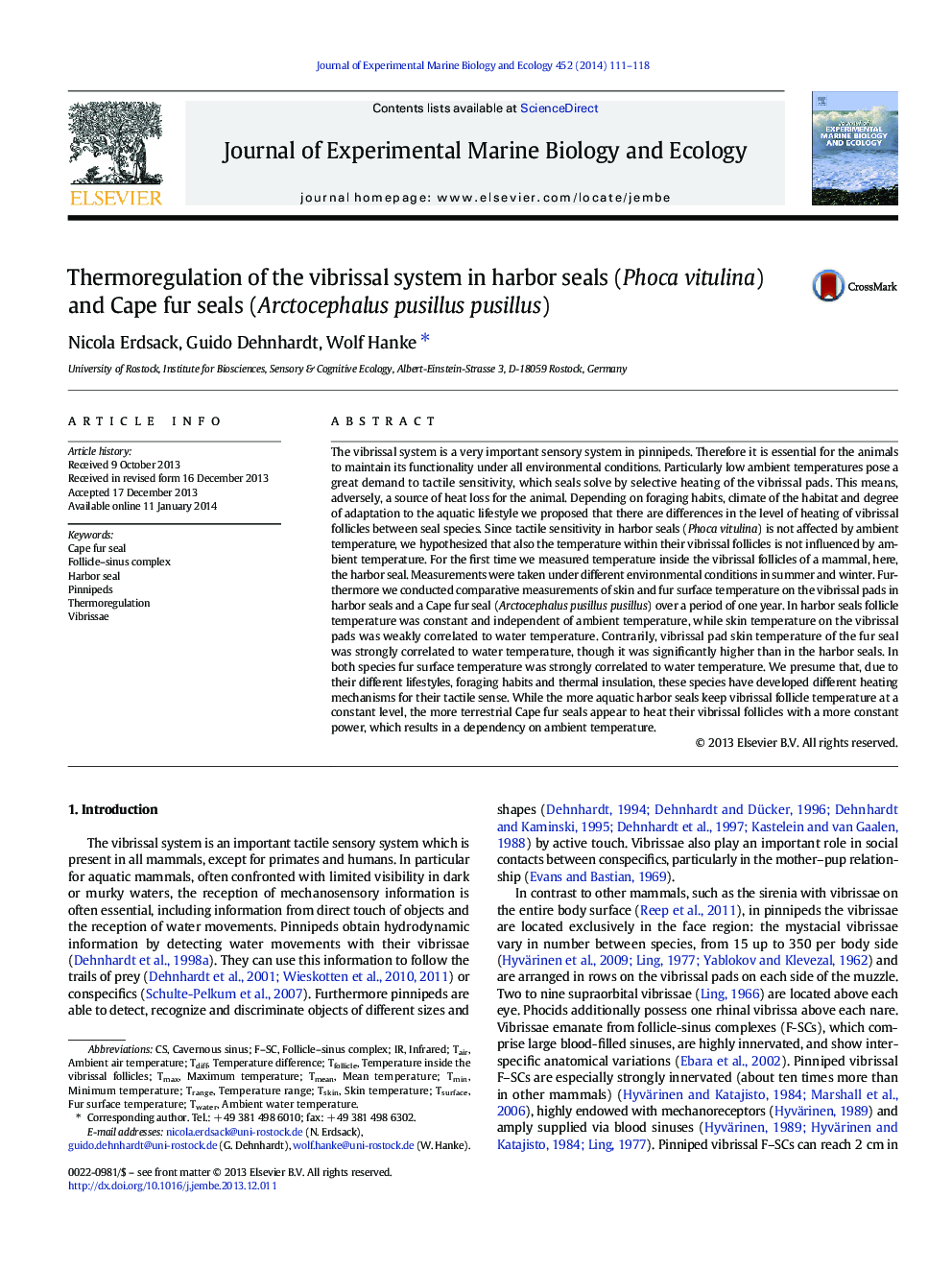| کد مقاله | کد نشریه | سال انتشار | مقاله انگلیسی | نسخه تمام متن |
|---|---|---|---|---|
| 4395561 | 1618423 | 2014 | 8 صفحه PDF | دانلود رایگان |
عنوان انگلیسی مقاله ISI
Thermoregulation of the vibrissal system in harbor seals (Phoca vitulina) and Cape fur seals (Arctocephalus pusillus pusillus)
دانلود مقاله + سفارش ترجمه
دانلود مقاله ISI انگلیسی
رایگان برای ایرانیان
کلمات کلیدی
vibrissaetmaxTminTskinTmeanThermoregulation - ترموستات یا دستگاه تنظیم حرارتTemperature difference - تفاوت دماMinimum temperature - حداقل دماMaximum temperature - حداکثر درجه حرارتMean temperature - دمای متوسطAmbient air temperature - دمای هوای محیطSkin temperature - دمای پوستPinnipeds - ریش تراشیدنTair - سهCavernous sinus - سینوس غشاییInfrared - مادون قرمز (فروسرخ)Temperature range - محدوده دماHArbor seal - چشم انداز HArbor
موضوعات مرتبط
علوم زیستی و بیوفناوری
علوم کشاورزی و بیولوژیک
علوم آبزیان
پیش نمایش صفحه اول مقاله

چکیده انگلیسی
The vibrissal system is a very important sensory system in pinnipeds. Therefore it is essential for the animals to maintain its functionality under all environmental conditions. Particularly low ambient temperatures pose a great demand to tactile sensitivity, which seals solve by selective heating of the vibrissal pads. This means, adversely, a source of heat loss for the animal. Depending on foraging habits, climate of the habitat and degree of adaptation to the aquatic lifestyle we proposed that there are differences in the level of heating of vibrissal follicles between seal species. Since tactile sensitivity in harbor seals (Phoca vitulina) is not affected by ambient temperature, we hypothesized that also the temperature within their vibrissal follicles is not influenced by ambient temperature. For the first time we measured temperature inside the vibrissal follicles of a mammal, here, the harbor seal. Measurements were taken under different environmental conditions in summer and winter. Furthermore we conducted comparative measurements of skin and fur surface temperature on the vibrissal pads in harbor seals and a Cape fur seal (Arctocephalus pusillus pusillus) over a period of one year. In harbor seals follicle temperature was constant and independent of ambient temperature, while skin temperature on the vibrissal pads was weakly correlated to water temperature. Contrarily, vibrissal pad skin temperature of the fur seal was strongly correlated to water temperature, though it was significantly higher than in the harbor seals. In both species fur surface temperature was strongly correlated to water temperature. We presume that, due to their different lifestyles, foraging habits and thermal insulation, these species have developed different heating mechanisms for their tactile sense. While the more aquatic harbor seals keep vibrissal follicle temperature at a constant level, the more terrestrial Cape fur seals appear to heat their vibrissal follicles with a more constant power, which results in a dependency on ambient temperature.
ناشر
Database: Elsevier - ScienceDirect (ساینس دایرکت)
Journal: Journal of Experimental Marine Biology and Ecology - Volume 452, March 2014, Pages 111-118
Journal: Journal of Experimental Marine Biology and Ecology - Volume 452, March 2014, Pages 111-118
نویسندگان
Nicola Erdsack, Guido Dehnhardt, Wolf Hanke,